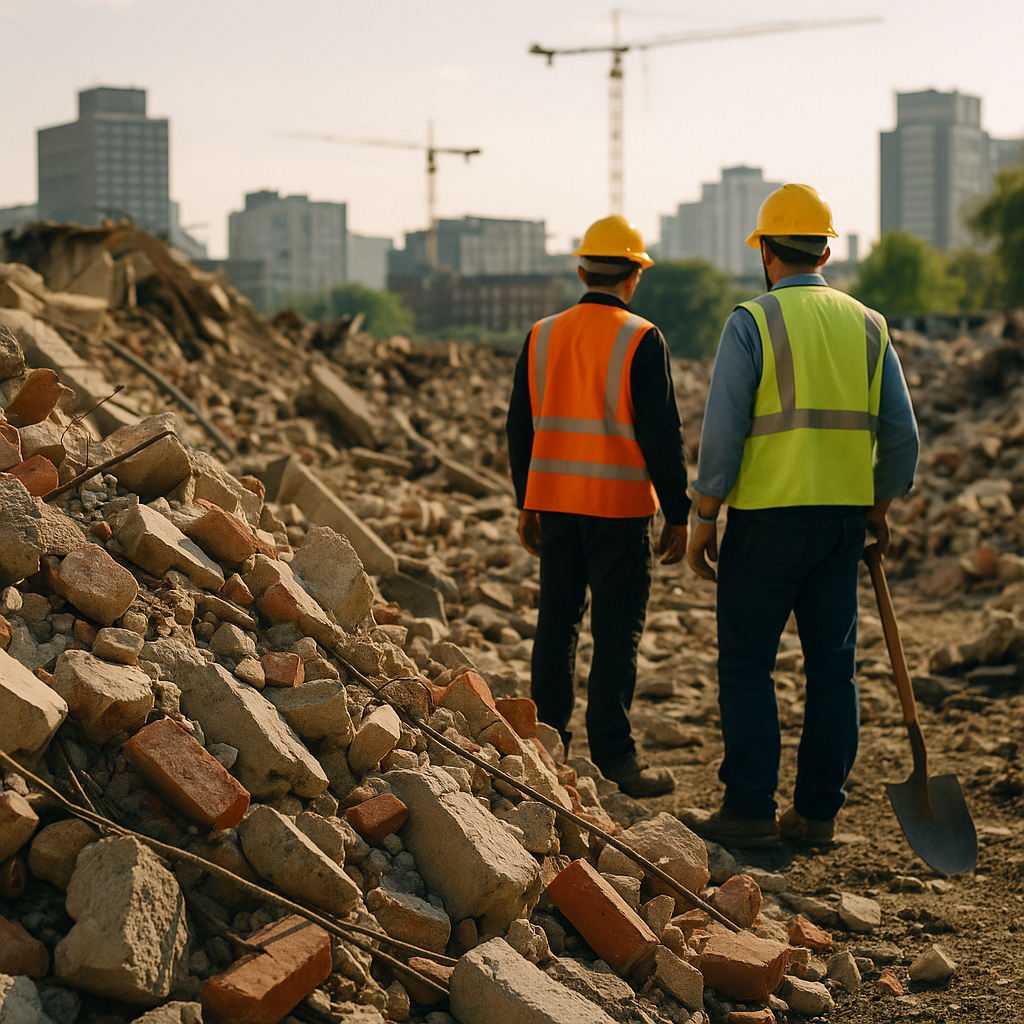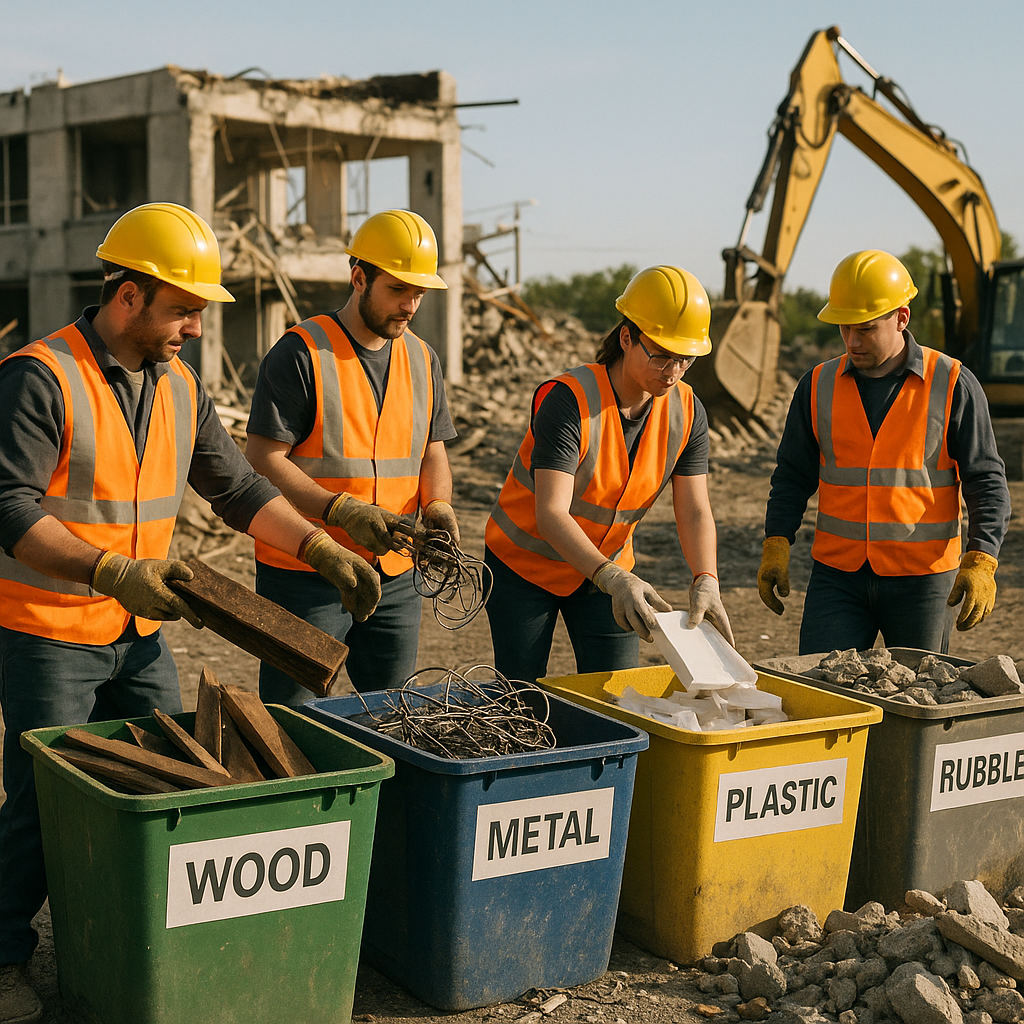5901 Botham Jean Blvd, Dallas, TX 75215
How to Handle Demolition Waste from Urban Expansion
August 7, 2025As cities expand outward or upward, the remnants of previous structures must be addressed. Demolition waste represents the physical aftermath of urban development—the concrete, metal, wood, and assorted materials left behind when old structures are cleared for new development.
With metropolitan areas worldwide experiencing significant growth, the volume of demolition debris has soared. This waste isn’t just discarded building materials. It includes a complex array of materials such as concrete, brick, wood beams, metal fixtures, drywall, and architectural components—all byproducts of our expanding urban footprint.
The scale of this challenge is immense. In many cities, demolition waste accounts for more than 60% of the total solid waste stream, overshadowing everyday household and commercial trash. As urbanization progresses globally, managing this surge of construction and demolition debris has become a critical environmental challenge for growing cities.
What are the Key Challenges of Managing Demolition Waste?

Demolition waste management faces several critical obstacles impacting cities, contractors, and waste processors. The volume of waste generated is immense—the United States produced 600 million tons of construction and demolition waste in 2018, more than twice the amount of municipal solid waste. Demolition activities account for over 90% of this total, putting a substantial burden on existing infrastructure.
Limited landfill capacity is another pressing issue. As urban centers expand, suitable landfill sites are diminishing. Many regions already struggle with insufficient space for waste disposal, resulting in waste being transported further distances at significant cost. This not only increases expenses but also generates additional greenhouse gas emissions from the vehicles involved.
Rising disposal costs are a major economic challenge. Landfill tipping fees continue to climb as available space decreases. Contractors often face tough decisions between managing higher costs for proper disposal and potentially resorting to improper waste management practices. These costs are typically passed on to property owners and developers, affecting overall project viability.
Environmental and Resource Concerns
Environmental impacts extend beyond landfill capacity issues. Demolition waste contains various pollutants, including heavy metals, polycyclic aromatic hydrocarbons, chlorides, and sulfides. If not properly managed, these substances can contaminate soil and groundwater. The leachate produced at landfills poses significant environmental risks to surrounding communities.
Resource depletion is another serious challenge. The construction industry consumes approximately 40% of raw stone, gravel, and sand globally, as well as 25% of wood resources. Continuing to discard valuable materials instead of recycling them accelerates the depletion of finite natural resources and increases carbon emissions associated with manufacturing new materials.
The industry’s carbon footprint is considerable, with construction and demolition activities accounting for 23% of air pollution, significantly contributing to climate change. Each ton of concrete sent to a landfill rather than recycled represents both wasted resources and missed opportunities to reduce emissions.
Practical Constraints for Implementation
Many urban construction sites face severe space constraints that hinder effective on-site waste management. The limited area makes it challenging to establish proper sorting zones and recycling systems. Without adequate space to separate materials, contractors often resort to sending mixed waste to landfills, even when recyclable materials are present.
Transportation logistics pose further challenges. Demolition waste is typically bulky and heavy, requiring specialized equipment and vehicles for handling. The costs and complexity of transporting different waste streams to appropriate processing facilities can be prohibitive, especially in crowded urban environments.
Lack of standardized processes across the industry further complicates waste management efforts. Inconsistent practices regarding material separation, handling procedures, and documentation make uniform solutions difficult to implement. This inconsistency poses additional challenges for waste processors and recycling facilities attempting to maintain quality control.
Economic and Cultural Barriers
Despite potential cost savings through recycling and reuse, many contractors remain resistant to changing traditional disposal practices. The belief that sustainable waste management is more expensive or time-consuming persists, even when evidence suggests otherwise. This resistance poses a significant barrier to implementing better waste management strategies.
Limited knowledge about recycling options and benefits among construction professionals also hinders progress. Without proper education on waste sorting, material recovery potential, and available recycling facilities, many demolition projects default to the simplest solution—sending everything to landfills.
Regulatory pressures add complexity. Governments worldwide are implementing stricter regulations on construction and demolition waste disposal, requiring increased documentation and compliance measures. Meeting these requirements demands significant investment in new processes and technologies, creating additional challenges for industry participants.
These multifaceted challenges require innovative solutions that balance environmental protection with practical and economic realities. The construction industry must address these obstacles to advance more sustainable demolition waste management practices and reduce its environmental footprint.
| Waste Management Strategy | Environmental Impact |
| Reuse | Preserves embodied energy; reduces waste generation |
| Recycling | Reduces pollution and greenhouse gas emissions; displaces primary raw materials |
| Recovery (incineration) | Produces energy but releases fossil CO2; reduces landfill waste |
| Disposal (landfill) | Space-intensive; risk of contaminating soil and groundwater |
What are Best Practices for Reducing Demolition Waste?

Demolition projects generate substantial amounts of waste. The construction and demolition industry produces approximately 600 million tons of debris annually in the United States alone. Implementing strategic waste reduction practices can significantly decrease environmental impact while offering notable cost savings. Here are effective strategies for reducing demolition waste.
Deconstruction Over Traditional Demolition
Deconstruction involves carefully dismantling buildings to salvage valuable materials for reuse. Unlike conventional demolition, which crushes materials into unusable debris, deconstruction preserves the integrity and value of building components.
The benefits of deconstruction extend beyond waste reduction. It creates more employment opportunities than traditional demolition methods. Workers can carefully remove reusable items like doors, windows, flooring, and fixtures that retain their market value. This approach also preserves finite resources, particularly old-growth wood products that are increasingly rare.
For optimal results, begin the deconstruction process by removing easily salvaged items first:
- Doors, hardware, and fixtures
- Appliances and HVAC equipment
- Cabinetry and architectural features
- Flooring materials, especially hardwood
- Structural timber and dimensional lumber
Develop Comprehensive Waste Management Plans
An effective waste management plan should be created during the pre-design phase of any demolition project. The plan establishes clear goals and procedures for waste reduction, recycling, and disposal. Begin by conducting a pre-demolition audit to identify recoverable materials and potential recycling opportunities.
Set specific, measurable waste diversion targets. Many projects aim to divert at least 50% of waste from landfills, with some municipalities and green building programs requiring diversion rates of 65% or higher.
Your waste management plan should include:
- Material inventory and recovery targets
- Designated sorting areas on-site
- Contact information for local recyclers and salvage organizations
- Training protocols for workers
- Documentation procedures for tracking diverted materials
Implement On-Site Sorting Systems
Effective on-site waste sorting is crucial for maximizing recycling potential. Create designated collection areas for different material types including wood, metal, concrete, drywall, and mixed debris. Clearly label containers and train all workers on proper sorting procedures.
For larger projects, consider using specialized equipment like mobile crushers for concrete and masonry. These machines process materials on-site, reducing transportation costs and creating usable aggregate for the project or nearby construction.
Regular site inspections help maintain sorting quality. When materials are properly separated at the source, they maintain higher value and are more likely to be accepted by recycling facilities.
Maximize Material Reuse
Many demolition materials have significant reuse potential. Common examples include:
- Brick and concrete can be crushed for use as fill, subbase material, or driveway bedding
- Wood can be processed into mulch, compost, or reused as lumber
- Metal components maintain high value in recycling markets
- Gypsum from drywall can serve as a soil amendment when properly processed
Establish relationships with local salvage yards and building material reuse centers. These organizations can often provide removal services for salvageable items and give them a second life in new construction projects.
Partner with Specialized Recycling Facilities
Research and partner with recycling facilities that specialize in construction and demolition waste. The capabilities of recyclers vary significantly by region, so investigate local options during the planning phase.
Coordinate logistics with recycling partners to establish efficient collection and transportation procedures. Some facilities offer on-site collection services or can provide specialized containers for different material types.
Remember that contamination reduces recycling value. Educate workers about proper material separation and what items recyclers will accept. Some facilities may reject entire loads if they contain prohibited materials.
Use Recycled-Content Materials in New Construction
To truly close the loop, specify recycled-content materials in any new construction that follows demolition. This creates demand for recycled products and supports the circular economy. Options include:
- Recycled-content insulation
- Concrete containing recycled aggregate
- Reclaimed wood products
- Steel with high recycled content
- Carpeting and flooring made from recycled materials
| Concrete | 51-62% |
| Asphalt | 55-67% |
| Metals (Steel, Aluminum) | 100%+ |
| Clean Wood | 46-71% |
| Mixed Construction Debris | 27-60% |
By implementing these best practices, demolition projects can significantly reduce waste while recovering valuable resources. The key is early planning, consistent implementation, and commitment to maximizing material recovery. These approaches not only benefit the environment but also often result in cost savings through reduced disposal fees and material resale opportunities.
How Can Cities Improve Demolition Waste Management?
Cities nationwide are implementing strategies to transform how demolition waste is managed. By mandating detailed waste management plans before project approval, municipalities ensure accountability and establish clear paths for material recovery. These plans typically outline strategies for material separation, recycling targets, and disposal methods.
Setting ambitious yet achievable recycling targets provides measurable goals for contractors. San Jose, California, has implemented a Construction and Demolition Diversion Deposit Program, requiring projects to recover at least 50% of waste generated. City projects must meet an even higher standard of 75%. This deposit-based system financially motivates contractors while creating documentation to track progress.
Education and technical assistance are also crucial to municipal strategy success. In Portland, Oregon, a waste management specialist conducts random site visits to offer guidance rather than immediate fines. This collaborative approach helps contractors understand requirements and identify cost-effective recycling opportunities.
Economic incentives have proven especially effective in driving behavior change. Incentives may include reduced permit fees for projects with comprehensive waste management plans, rebates for exceeding recycling targets, or tax incentives for using recycled materials. Some cities have implemented deposit systems, refunding contractors who comply with recycling requirements.
Investing in local recycling infrastructure is essential to processing demolition materials. Cities can support the development of specialized facilities for processing materials like concrete, wood, and metal. King County, Washington, maintains a directory of processors and supports market development for recovered materials through its Construction, Demolition, and Land clearing Program.
Creating and supporting markets for recycled materials completes the circular economy loop. Oakland, California, evaluates waste management plans partly based on the feasibility of recycling targeted materials under local market conditions. Cities can help develop these markets by requiring recycled content in municipal construction projects and connecting processors with potential end-users.
Collaborative approaches involving multiple stakeholders yield the best results. When municipalities, contractors, waste processors, and material manufacturers collaborate, innovative solutions emerge. For example, some cities are exploring local processing of gypsum wallboard and rigid foam insulation, avoiding the need for long-distance shipping for recycling.
Successful Municipal Approaches
Municipalities nationwide employ three broad strategies for demolition waste management. Some cities rely on market forces to drive recycling, focusing on materials with established economic value. Others adopt a middle path, requiring waste management plans and providing technical assistance. The most ambitious approach mandates recycling, requiring documentation and imposing penalties for non-compliance.
New York City faces unique challenges that require tailored solutions. Limited staging areas at construction sites complicate material separation. The Wicks Law, which mandates four prime contractors on public projects over $50,000, further complicates coordination efforts. Additionally, higher labor costs can make intensive recycling seem prohibitively expensive.
Despite these challenges, cities like San Jose show that comprehensive programs can deliver impressive results. Their deposit system boasts a 98% compliance rate, with nearly all contractors providing the necessary documentation. This success has encouraged processors to invest in additional capacity for recycling options beyond basic landfill diversion.
The economics of recovery versus disposal have already fostered a substantial demolition waste recycling industry in many cities. As landfill costs rise and transportation distances increase, the financial rationale for recycling strengthens. Cities that anticipate these trends and build the right infrastructure and policies now will be better positioned for the future.
To maximize effectiveness, cities should develop policies that recognize the diversity of demolition projects. A one-size-fits-all approach rarely works well. Oakland’s flexible system evaluates recycling goals based on project specifics and local market conditions rather than imposing uniform targets. This nuanced approach recognizes that different projects generate different waste streams with varying recycling potential.
Conclusion: The Future of Urban Demolition Waste Management

As urban centers progress through development and redevelopment, managing demolition waste has become both a significant challenge and a promising opportunity. The shift from seeing demolition materials as mere waste to valuable resources represents a crucial change in sustainable urban planning. By adopting systematic waste management strategies—such as reuse, recycling, or recovery—cities can reduce environmental impacts while creating economic value.
The future of urban demolition waste management depends on decision-making processes that consider factors beyond simple economics. Technical feasibility, environmental benefits, and social impacts must all be evaluated when determining how to handle materials from demolished structures. Cities that implement comprehensive waste management strategies will not only conserve natural resources but also reduce landfill use, lower greenhouse gas emissions, and potentially generate new revenue streams from reclaimed materials. For professional guidance on implementing effective metal recycling solutions for your demolition projects, contact Okon Recycling at 214-717-4083.
